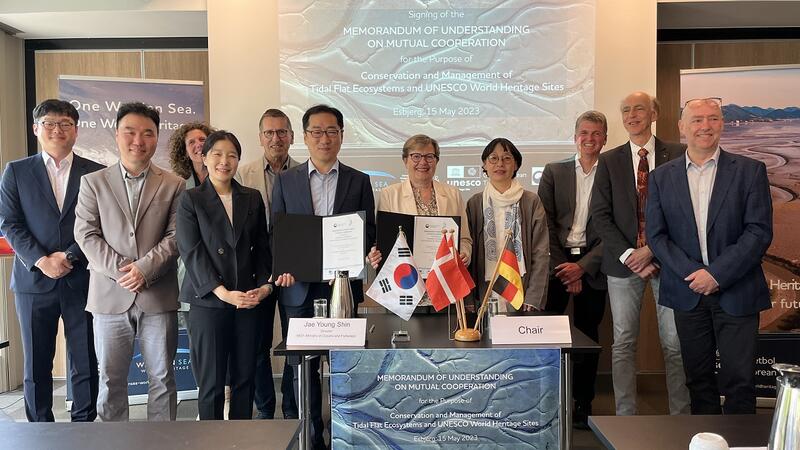Update to Memorandum of Understanding between Wadden Sea and Korean Getbol signed

The Wadden Sea may be the largest unbroken tidal flats system in the world, where processes run largely undisturbed. But it is not the only extensive sand and mudflat ecosystem. A seascape comparable in size and significance to global biodiversity exists in the Yellow Sea across the coastline of the Republic of Korea, the Democratic People's Republic of Korea, and People's Republic of China. Parts of the South Korean tidal flats called Getbol have been inscribed in UNESCO’s World Heritage List in 2021 – a success as it underlines the global importance our tidal flats around the world. Since 2009, the Republic of Korea and the countries of the Trilateral Wadden Sea Cooperation have been in mutual exchange – on topics such as management, environmental education, and sustainable tourism, but also on the Wadden Sea’s experience in becoming a World Heritage Site. Now that both sites carry this title an update to the Memorandum of Understanding underlining the cooperation was due.
As World Heritage Sites there is an increased joint responsibility in implementing the World Heritage Convention in cooperation with all involved stakeholders. This concerns protection and management measures at ecosystem level, exchange of experiences in habitat restoration, cooperation in scientific research such as blue carbon, as well as dealing climate change, and energy transition such offshore wind farms. Another important topic is environmental education and awareness raising e.g. by supporting visitor centres integrating the World Heritage programme. Over the past ten years, regular study visits have been carried out coordinated by Ji Young Jang (EcoHorizon, Korea) and Anja Szczesinski (WWF Germany).
“The cooperation with Korea is of great importance for the Wadden Sea”, says Soledad Luna, responsible for international cooperation at the Common Wadden Sea Secretariat. “The Yellow Sea faces similar challenges as the Wadden Sea and we can profit from exchanging our experiences how to deal with them, also at a global scale, and enhance the profile of our cooperation internationally”.
“Korea and the Wadden Sea countries will further strengthen the conservation and management of their mudflat systems as World Heritage Sites through the updated MoU”, says Jae-Young Shin, Director of Korea's Ministry of Oceans and Fisheries. “I hope we will continue working together as partners to discuss various issues related to the ocean, such as energy transition, blue carbon, as well as mudflats.”
Since 2009, many new tidal flat areas in South Korea have been designated as protected areas. To date, 15 areas have been designated as protected areas and large parts are inscribed on the World Heritage List. This has further increased the public awareness for the Getbol as one of most important sites for migratory birds and biodiversity.
Since signing the MoU in 2009, about 240 experts have participated in exchange, involving over 2,600 persons at both sites. The MoU has raised the profile of both areas regarding protection of tidal flats nationally and internationally, underlined the necessity to provide scientific knowledge for management, strengthened the capacity for communication and education, and provided many valuable examples for practitioners which they can apply at their site.
